
The most important complex basic exercises in strength training with weights are sometimes also called the Big Six. If you train with your own body weight, these exercises have to look a little different.
In this article, I’ll show you why you should also integrate the basic exercises into your bodyweight training plan and how you can adapt them to your fitness level.
The Big Six basic exercises in bodyweight training
The concept of the “Big Six” comes from the research of Dr. Richard Schmidt. The whole thing was then further developed and adapted by the two fitness coaches Alwyn Cosgrove and Lou Schuler in their book The New Rules of Lifting *.
But when can an exercise be called a basic exercise?
If it meets the following four requirements:
- It is functional. This means that the exercise depicts everyday movement patterns .
- It uses a lot of muscle mass
- You need a lot of energy to do it.
- It comprises more than just a joint .
The Big Six in weight training are:
- Squats
- lunges
- Deadlift
- Press
- Drag
- torso rotation
Good and beautiful.
Now you know which exercises (and variations from them) are good for you when you train with weights.
But: A gym membership costs money , the trip to the gym costs time, that you lack for sport , and the equipment for home is not exactly good either cheap.
Wouldn’t it be cool if you could do all of this without weights?
But is it enough then to simply leave the weight plates off?
Unfortunately no!
Basic exercises in bodyweight training
In bodyweight training, other intensity techniques are used instead of the weight plates.
But first let me show you the 7 basic exercises in self-weight training, which I also use in my training plans . These exercises did not grow on my crap alone, Paul Wade also uses them to a large extent in his book Training like in prison *.
# 1 push-ups
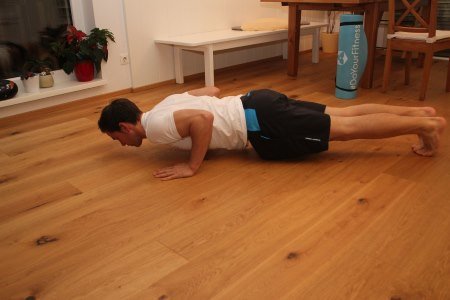
The classic among bodyweight training exercises. The exercise is so popular that some time ago a major push-up challenge went around the world.
Stressed muscles: You mainly train the back of your upper arm (triceps brachii muscle) and chest muscles (pectoralis muscle). But the stabilizing muscles of your body also work at full speed when you are in one of the push-up positions.
Correct technique: Place your hands about shoulder width apart and make sure that your upper arms and elbows are close to your body. Then bend your arms so that your chest touches the surface of your hands. Then stretch your arms again and maintain your body tension.
Frequent mistakes: Working with momentum and spreading the arms too far outwards should be avoided. Likewise, your body has to stay in line, avoid coming up with your upper body first.
# 2 shoulder press
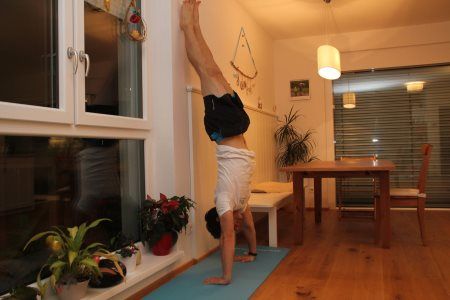
The top class of this exercise is the handstand push-ups.
Stressed muscles: You mainly train the back of your upper arm (Triceps brachii muscle) and shoulder muscles (Deltoideus muscle).
Correct technique: Put your hands about shoulder width apart. In contrast to the push-ups, your arms can be spread apart from your upper body. You are not pressing so hard with your upper arms, but more with your shoulders. Your head should touch the surface of your hands when your arms are bent.
Common mistakes: Drifting into push-ups (make sure that you are working “overhead”).
# 3 pull-up
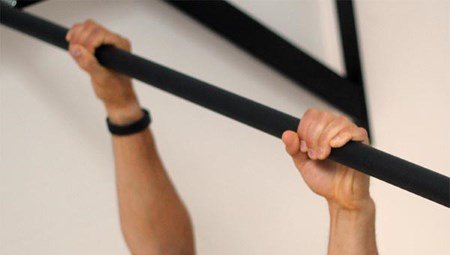
For me the proof of how much relative power lies dormant in you. The more often you can lift your own body, the higher this force.
Stressed muscles: You mainly train your upper arm (M. biceps brachii and brachialis) and your broad back muscle (M. latissimus dorsi).
Correct technique: You can do pull-ups on the pull-up bar with different grip techniques. If you want to do more for your upper arms, the comb handle is the right choice. Your palms are facing you. I recommend the overhand grip (instep grip), with the back of your hand facing you (like the other fingers, you can put your thumb over the bar or around the bar), because you are doing your latissimus can address better. In any case, it is important that you use the full range of motion, i.e. go down into the slope (but keep your shoulders tense) and go as high as you can – at least with your head over the bar.
Common mistakes: Half repetitions (don’t go all the way down), work with leg swing. Concentrate on performing calm movements to counteract this.
# 4 squat
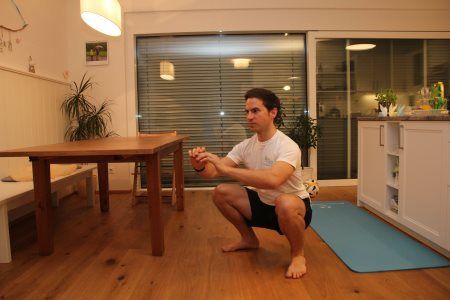
Without weights, the squat may seem ridiculously easy to you. Do not underestimate the possibilities that one-legged variants offer you!
Stressed muscles: You mainly train your front thighs (M. Quadriceps femoris), your buttocks (M. Gluteus maximus), your thighs (Ischiocrural muscles) and your back extensor (M. erector spinae).
Correct technique: Stand about shoulder width apart. Your feet can be turned slightly outwards. Make sure that the sole of your foot always remains completely on the ground (imagine three points – two for your toes, one for your heel – that should stay on the ground) and bring your knees forward towards the tips of your feet (they may also protrude slightly above your toes). Make sure that your upper body stays upright and stretched. You can use your arms as a counterweight in front of your body.
Frequent mistakes: You are not going deep enough (with the half knee bend 90 °, with the deep knee bend thighs and lower legs touch each other), your feet are twisted too far, the soles of your feet do not touch completely the floor, you do not squat with the full range of motion, your standing position is too far or too tight, your knees fall inward or your upper body does not stay upright.
# 5 Leg lifter
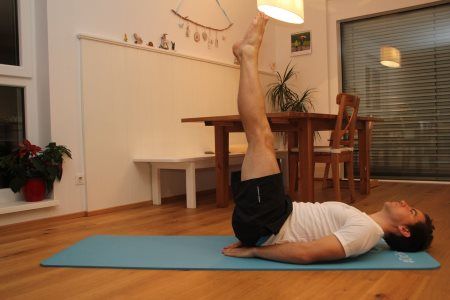
Do you want to have decent abs? Then the leg lifter in its variations is the right exercise for you.
Stressed muscles: You mainly train your hip flexors (M. psoas major) and your abdominal muscles (especially M. rectus abdominis), but also your front thighs.
Correct technique: Lie on your back on the floor and keep your feet close together. Lift your legs upright, making sure that your lower back stays in a neutral position. There should be some space underneath, but no hand should fit underneath.
Common mistakes: You hold the legs with the joints of the spine (sagging / hollow back).
# 6 bridge
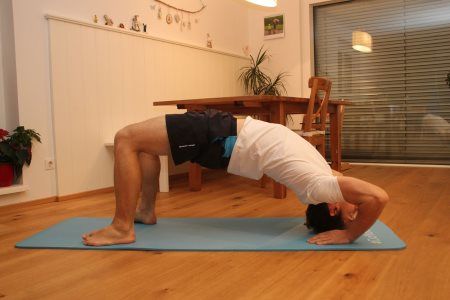
A little known exercise that can transform your back into a steel corset for your spine. 😉
Stressed muscles: You mainly train your back muscles (especially M. erector spinae), but also your legs and upper arms (M. triceps brachi).
Correct technique: With the bridge, the most important thing is to bend your back as much as possible. Since you do it with the help of your muscular strength, you have no injuries to fear. However, increase a little more slowly than you might do with the other exercises.
Common mistakes: Too shallow bend in the back (gets better over time), feet too far forward, hands too far away from the head.
# 7 Burpees

Who doesn’t know the ultimate cardio exercise with your own body weight? For me it is the ultimate when it comes to increasing endurance performance.
Stressed muscles: You train your whole body with it. Since it is not a specific strength exercise, but a combination exercise, you have more of an effect on your cardiovascular system and thus your endurance.
Correct technique: From a standing position, you crouch down, leaving your feet on the floor and slightly reaching in front of and outside your feet on the floor. Then you jump backwards, do a push-up and jump forward again. Then you do a stretch jump and come back to the starting position.
Common mistakes: Shoulders and core are not tense or you choose too difficult variants for training.
Interim conclusion on the basic exercises in bodyweight training
The basic exercises contain 6 muscle building and one cardio exercise. So you can cover almost the entire spectrum of bodyweight training.
What is still missing is the training of your mobility – for me there is no “one” exercise, but rather an interplay of different mobility drills and mobility flows.
Mobility drills are three-dimensional, actively controlled movements that increase the active ROM (Range of Motion). Active means, using your own muscle power, after consciously controlling these muscles, performing the desired movement in a controlled manner. The increased ROM is created by a balance between agonist (moving muscle) and antagonist (opponent), in that the antagonist is drawn (“stretched”) in the three-dimensional movement by activating the agonist, and the agonist is strengthened at the same time.
Mobility flows are made up of several mobility drills.
Back to the exercises presented: For each of the exercises above, I introduced you to the classic. Sometimes this variant is very difficult to implement, sometimes easy.
That means, in order to make good progress, you have to adapt the exercises to you.
Adapt the basic exercises to your fitness level
You now know the basic exercises in bodyweight training.
But what if you can do 50 squats with no problems and want to build muscle?
Then you have to think about how you can bring the number of repetitions below 15. You can do this with weights in the studio, or with intensity techniques for self-weight exercises.
Because training to the point of muscle failure with a repetition number of 6 to 15 is what scientific studies on the subject currently consider most effective if you want to build muscle .
The other way around it works the same way: What if you can’t do a classic push-up yet? Then you have to make the exercise easier. Techniques for simplification can also help here.
To put it simply, it is a question of what options there are to make exercises more difficult or to make them easier:
Leverage
Since you can manage with your own body weight without additional weights during training, you have to use your body correctly to make the exercises easier or more difficult. Using the example of push-ups, you make the exercise more difficult if you raise your legs, you make the exercise easier if you raise your arms or place your hands closer together.
Range of motion (ROM)
The “Range of Motion” (ROM) for bodyweight exercises should basically be as large as your joint allows. If you are not yet strong enough for individual exercises, you can break this rule and, for example, do not push-ups all the way to the floor, but only up to half the height.
Exercise speed
If you increase the “time under tension” – the time in which your muscles are under tension – you also make the exercise more difficult. This means that if you normally do the push-up very quickly, try doing it with 2 seconds when lowering and 2 seconds when pressing up. You will see that this makes the exercise a lot more difficult.
Another possibility are negative sentences: You only slow down the eccentric (yielding) movement phase. To stick to the example of push-ups, that would be 1-2 seconds when pushing up, but 3 to 5 seconds – so very slowly – when going back down.
One-sidedness
The premier class of bodyweight exercises takes place with only one side of the body. As a result, your entire body weight is only on one arm, for example during push-ups. This is the point in time when you can train yourself to truly “superhuman” strength – without additional weights.
Training methods
You can just start training or you can choose training methods that help you achieve your goals . I recommend the latter: On my blog, I am introducing you to the 7 best training methods for self-weight training . In my ebook on bodyweight training * and the associated training plans you will get a few more.
Conclusion on the basic exercises in bodyweight training
The 7 basic exercises for body weight training should be the foundation of your bodyweight training plan.
Make sure that you adapt the exercises to your fitness level and your goals.
This is how you can achieve rapid and sustainable progress.
Which of the presented basic exercises do you already use regularly in your training? Which do you want to include in the future?
If you want to know more about bodyweight training and learn how to use it optimally for your goals, take a look at my eBook P.A.T. Bodyweight training *. The book has over 85 exercise instructions with videos and nine different training plans, all of which you can adapt to your goals. With the discount code “fitvolution” you as a Fitvolution reader even get a 15% discount on the package. Jahn also listed it among his recommendations as one of the top fitness books.
Have fun training, keep moving!
Your Pat
Pat is the founder and lead author of 4yourfitness.com . He is the managing director of a sports association, sports scientist, qualified nutrition trainer and father of a family. On his blog you can get a lot of good tips and free training plans with self-weight exercises.
